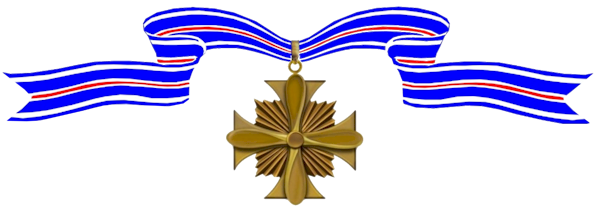The President of the United States of America takes pleasure in presenting a Fourth Gold Star in lieu of a Fifth Award of the Distinguished Flying Cross to Captain Arch Ratliff, Jr. (MCSN: 0-89061), United States Marine Corps, for heroism and extraordinary achievement while participating in aerial flight while serving as a Pilot with Marine Light Helicopter Squadron THREE HUNDRED SIXTY-SEVEN (HML-367), Marine Aircraft Group Sixteen, FIRST Marine Aircraft Wing, in connection with military operations against the enemy in the Republic of Vietnam. From 28 January to 23 March 1971, Captain Ratliff participated in Operation LAM SON 719 as Aircraft Commander of an AH-1G Cobra helicopter and launched on thirty-one combat missions involving thirteen point two flight hours to provide armed gunship support for CH-53 transport helicopters resupplying Army of the Republic of Vietnam fire support bases which were under heavy attack from North Vietnamese Army forces deep in enemy-controlled territory. Undaunted by constant exposure to intense hostile anti-aircraft fire as he approached each of the beleaguered positions, he ably established and maintained communications with the supported units, passed on significant information to the transport pilots, alertly located enemy firing positions, boldly maneuvered his aircraft on repeated rocket and strafing runs, and delivered his ordnance with such devastating effectiveness that the transports were able to deliver their cargo safely to the drop zones. While Leader of a flight of four Cobras during the emergency mission of extracting artillery pieces and the medical evacuees from Fire Support Base HOTEL II on 26 February, at a time when the base had been surrounded for three days and the extremely heavy volume of North Vietnamese fire had downed two friendly aircraft, Captain Ratliff completely disregarded his own safety as he skillfully maneuvered his gunship along a narrow approach corridor to lead the transport aircraft toward the drop zone and then fearlessly executed low altitude passes over the zone to draw the hostile fire away from the transports. When one of the transports was damaged by enemy mortar fire, he boldly positioned his aircraft between the enemy fire and the crippled transport as he covered its departure from the dangerous area. Captain Ratliff’s courage, superior airmanship, and unwavering devotion to duty in the face of great personal danger were instrumental in accomplishing the hazardous missions and were in keeping with the highest traditions of the Marine Corps and of the United States Naval Service.

Awards Received
-

Silver Star
-
Silver Star
Service:
United States Marine CorpsRank:
CaptainBatallion:
Marine Medium Helicopter Squadron 363 (HMM-363)Division:
1st Marine Aircraft WingAction Date:
October 22, 1967
The President of the United States of America takes pleasure in presenting the Silver Star to Captain Arch Ratliff, Jr. (MCSN: 0-89061), United States Marine Corps, for conspicuous gallantry and intrepidity in action while serving as a Pilot with Marine Medium Helicopter Squadron THREE HUNDRED SIXTY-THREE (HMM-363), Marine Aircraft Group Sixteen, FIRST Marine Aircraft Wing, in connection with combat operations against the enemy in the Republic of Vietnam. On the night of 22 October 1967, Captain Ratliff launched as Division Leader of a flight of four UH-34 transport helicopters assigned to extract an eight man Marine reconnaissance team which was surrounded by a numerically superior North Vietnamese Army force four miles south of Dong Ha. Arriving over the designated area, the extraction helicopters orbited overhead until the armed helicopters and AC-47 aircraft completed their fire suppression runs against the enemy force. Leading the first section of aircraft in an approach to the landing zone, Captain Ratliff immediately came under intense hostile automatic weapons fire and lost sight of the single strobe light that marked the site. Disregarding the enemy fire, he unhesitatingly continued his approach and, when he regained visual contact with the strobe light, skillfully landed his aircraft in the fire-swept zone. When his wingman was forced to abort his landing attempt, due to the heavy volume of enemy fire, Captain Ratliff realized that his helicopter would be unable to extract the eight men and that to embark half of the reconnaissance team leaving only four Marines in the zone would increase the possibility of the remainder of the team being overrun by the large enemy force. After embarking one Marine, Captain Ratliff lifted out of the zone and returned to Dong Ha while fixed-wing aircraft attacked the North Vietnamese Army force. Subsequently returning to the beleaguered unit’s location, he resolutely led his division onto another approach heading into the zone, with the four aircraft in a close trail formation, the two lead helicopters with their external lights turned out and the remaining aircraft with their lights turned on. During the approach to the landing zone, he again came under intense enemy automatic weapons fire. With complete disregard for his own safety, he fearlessly continued his approach. At 200 foot altitude, the second section aborted the landing, as ordered by Captain Ratliff, and diverted the enemy’s attention and a major portion of the ground fire, enabling the first section to continue into the landing site. Expeditiously embarking three of the Marines while his wingman embarked the remaining four, Captain Ratliff lifted out of the zone and returned safely to Dong Ha. His exemplary airmanship and sincere concern for the welfare of his comrades were an inspiration to all who observed him and contributed significantly to the accomplishment of the hazardous mission. By his courage, exceptional aeronautical ability and unwavering devotion to duty at great personal risk, Captain Ratliff upheld the highest traditions of the Marine Corps and of the United States Naval Service.

